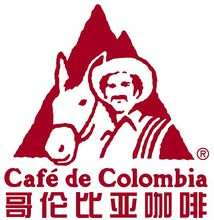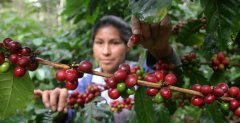World Map of Coffee-- all kinds of Coffee in Colombia

For professional baristas, please follow the coffee workshop (Wechat official account cafe_style)
It is often said that "high-quality South American coffee looks like Central America," meaning that Central American coffee is superior to South America, which mainly produces commercial coffee, in terms of beans, soil, and even treatment. But I think Colombia is an exception: on the cup test table, the highest-scoring boutique coffee is generally floral and fruity. The best Colombian coffee will also have a thick taste. Anyone who has experience in roasting will know that it is a mixed coffee of both shades and shades.
Volcanic soil + family management
Colombia is located in the northwest of the South American continent, bordering Central America and Panama. From the aerial view, it looks like it has been scratched by a cat on the west side, leaving three vertical paw marks from north to south. The country's famous producing areas are scattered in these fertile volcanic soil in the Andes (Cordillera).
It is said that coffee was introduced by missionaries from Venezuela in 1730 and was grown in the southeast of the country. Later, due to civil war and political reasons, it gradually moved to the western mountainous areas. In an ideal environment of high height and volcanic soil, Colombian coffee has been respected by high-end consumers in the United States and Japan since the 1940s. In addition to the inherent conditions, there is another main reason why Colombian coffee is better than Brazil: family management. They do not have heavy machinery to harvest and irrigate, nor do they have spare money to hire workers. All coffee fruits are not picked by hand until they are ripe. They cherish the piece of land they live in, from choosing fertilizer to reclamation will be enough, so there is less land fatigue. Apart from coffee, they will also grow other crops to eat or earn extra money. All these help to maintain the ecological environment.
Since 1927, Colombian farmers have organized trade unions (National Federation of Coffee Growers of Colombia) to protect each other's rights and interests. They think that "when customers can tell the difference and are willing to pay extra for it, it is boutique coffee." With a donkey dragged, a hat and a beard printed on a coffee bag from Colombia, this fictional character, a well-known fictional character in America, has been a symbol of coffee in the country since 1981. In addition, there is Parque Nacional del Caf é, an amusement park with coffee as its theme. It can be seen that Colombians are proud of producing quality coffee.
Research and development of disease-resistant soybean seeds
In terms of research, the official agency Cenicafe is responsible for the development of high-yielding and disease-resistant soybean seeds. Rust began to ravage Colombia in 1983, but before that, they had mixed common Caturra and Timor varieties with the robusta gene and developed disease-resistant Variedad Colombia from other countries. After the millennium, varieties such as Tabi (Typica, Bourbon and Timor) and Castillo (disease resistant species of Caturra) were introduced successively. Although robusta, which is often used as instant coffee, is not pure, this year's national COE competition runner-up and second runner-up coffee are mixed with Castillo varieties! It can be seen that disease resistance and taste can coexist.
As for the producing areas, famous ones include Huila, Cauca, Narino and Tolima. Among them, Huila has arranged 16 places in the top 20 places in COE this year. However, climate warming has caused temperatures in the mountains to rise, and highlands that have never been affected by the disease before are also gradually affected. Coffee farmers face not only quality, but also production capacity that affects their livelihoods.
Patrick Tam (owner of the boutique coffee shop Knockbox, approved barista of the American Fine Coffee Association and European Fine Coffee Association, CQI recognized cup tester, Cup of Excellence's first Hong Kong judge)
Important Notice :
前街咖啡 FrontStreet Coffee has moved to new addredd:
FrontStreet Coffee Address: 315,Donghua East Road,GuangZhou
Tel:020 38364473
- Prev

Starbucks Colombian Coffee producing area Colombian Coffee Best Coffee Variety, Flavor and Story
For professional baristas, please follow the coffee workshop (Wechat official account cafe_style). This coffee is grown on the highest coffee farm in the magnificent Andes and has a well-balanced flavor. In the delicate taste of this coffee, will leave a slightly dry taste in the mouth, just like after eating walnuts, the rest of the taste in the mouth, clean and refreshing.
- Next

The rich bitter cocoa aroma of Honduran coffee is like a healing coffee journey.
For the exchange of professional baristas, please pay attention to the coffee workshop (Wechat official account cafe_style) Honduras has become the second largest coffee exporter in Central America and the tenth largest coffee exporter in the world, with small coffee farmers accounting for the vast majority of the 280000 hectares of coffee plantations. Ecological Green Honduran Coffee from COAGRICSAL Cooperative, located in western Honduras, 1998
Related
- Does Rose Summer choose Blue, Green or Red? Detailed explanation of Rose Summer Coffee plots and Classification in Panamanian Jade Manor
- What is the difference between the origin, producing area, processing plant, cooperative and manor of coffee beans?
- How fine does the espresso powder fit? how to grind the espresso?
- Sca coffee roasting degree color card coffee roasting degree 8 roasting color values what do you mean?
- The practice of lattes: how to make lattes at home
- Introduction to Indonesian Fine Coffee beans-- Java Coffee producing area of Indonesian Arabica Coffee
- How much will the flavor of light and medium roasted rose summer be expressed? What baking level is rose summer suitable for?
- Introduction to the characteristics of washing, sun-drying or wet-planing coffee commonly used in Mantenin, Indonesia
- Price characteristics of Arabica Coffee Bean Starbucks introduction to Manning Coffee Bean Taste producing area Variety Manor
- What is the authentic Yega flavor? What are the flavor characteristics of the really excellent Yejasuffi coffee beans?

